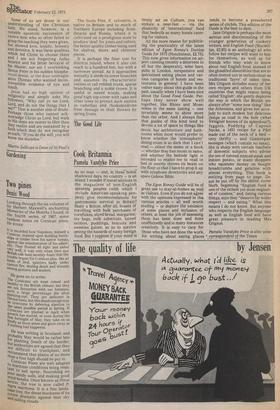The Good Life
Cook Britannia
Pamela Vandyke Price
As no man — and, in these—bon-Ili shadowed days, no country — is an island, I wonder if travel sections in the magazines of non-English speaking peoples (with which I include American-speaking peoples), give recommendations for gastronomic survival in Britain? Many a Briton, after all, boasts of travelling with bulk purchases of cornflakes, sliced bread, margarine, tea bags, milk substitute, tinned salmon, puddings, biscuits and sweeties galore, so as to survive among the hazards of nasty foreign
food. But I suppose if your mind is _ firmly set on Culture, you can endure a near-fast — via the plasticity of 'international' food that bedevils so many hotels catering for visitors.
All the more reason for publicising the practicality of the latest edition of Egon Ronay's Dunlop Guide for 1975 (Hutchinson, £2.75). This now gives information on airport catering (mostly a deterrent to all but the desperate), wine bars, pubs in London, inexpensive and specialised eating places and various categories of hotels and restaurants in general. I have been rather nasty about this guide in the past, usually when I have been nice about the Good Food Guide. Perhaps they never show well together, like Rhine and Mosel wines in the same tasting — one invariably seems to shine more than the other. And I always find that guides of this kind tend to devote a lot of space to things like decor, bar architecture and bathrooms when most would prefer to know whether the 'atmospheric' dining-room is so dark that I can't read — either the menu or a book — whether they ban music in same, and whether the bedside light is intended to enable me to read in bed or merely throws its beam on the floor so that I have to prop it up with telephone directories and any spare Gideon Bible.
The Egon Ronay Guide will be of great use to stay-at-homes as well as Visitors. Even if you do not agree with the opinions expressed in the various articles — all well worth reading — or deplore the omission of some places and inclusion of others, at least the job of assessing them has been done and done unaffectedly and in many instances creatively. It is easy to carp for those who have not done the work, for writing about eating places tends to become a preselected series of clichés. This edition of the Guide is the best to date.
Jane Grigson is perhaps the most serious and discriminating of the younger generation of cookery writers, and English Food (Macmillan, £2.95) is an anthology all who follow her recipes will want to buy for themselves, as well as for friends who may wish to know about real English food, instead of the glossified absurdities that are so often trotted out in technicolour as traditional 'fayre' of olden time. Mrs Grigson includes many of her own recipes and others from UK countries that might resent being called 'English'; she gently deplores the way in which the British are always after "some new thing" like the Athenians, and gives her accolade to such modest but delicious, -things as toad in the hole (what foreigner knows of its splendour?), faggots, Poddyng of Capoun Necke, a 1451 recipe for a Pâté made out of the neck of a bird — very thrifty — and Glamorgan sausages (which contain no meat). She is sharp with certain teachers of domestic subjects who advise the use of canned minced steak and instant potato, or inane shoppers who squander money on bought breadcrumbs and gelatine with almost everything. This book is enticing from page to page. Do not be put off by the idiotic cover blurb, beginning "English food is one of the richest yet most neglected of cuisines," and, listing various ' things, says they "deserve far wider respect — and eating." What this means I do not know. But anyone who respects the English language as well as English food will have great pleasure in reading Mrs Grigson.
Pamela Vandyke Price is also wine
• correspondent of the Times _


































 Previous page
Previous page